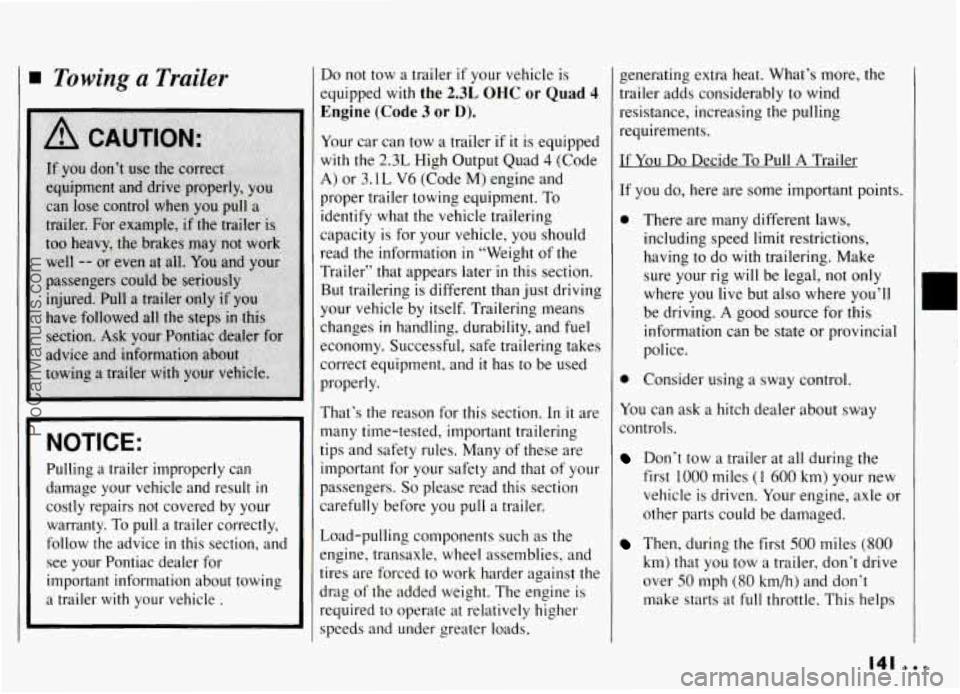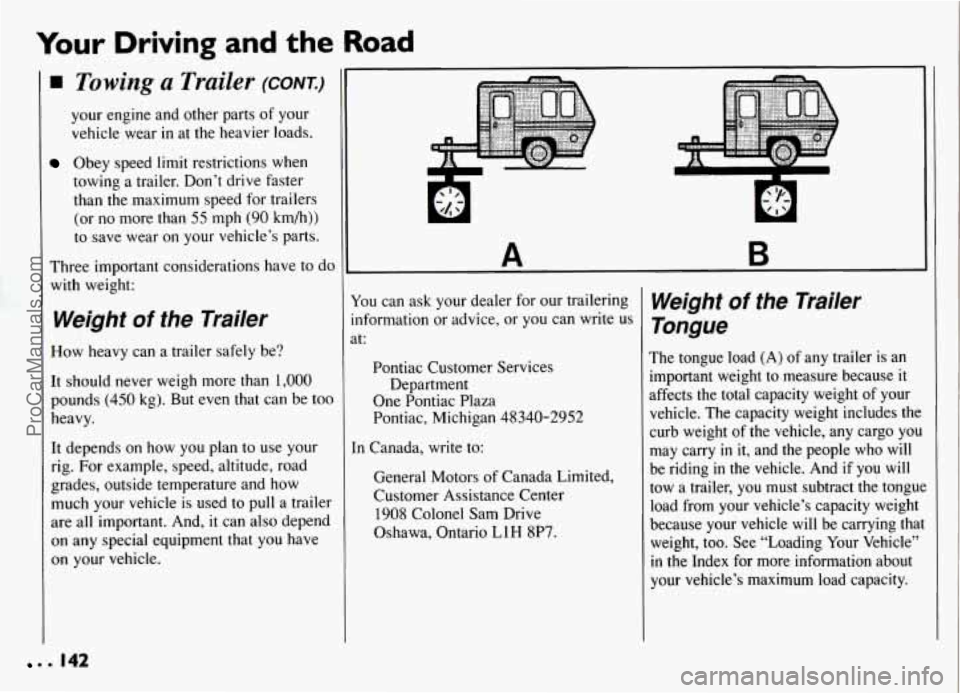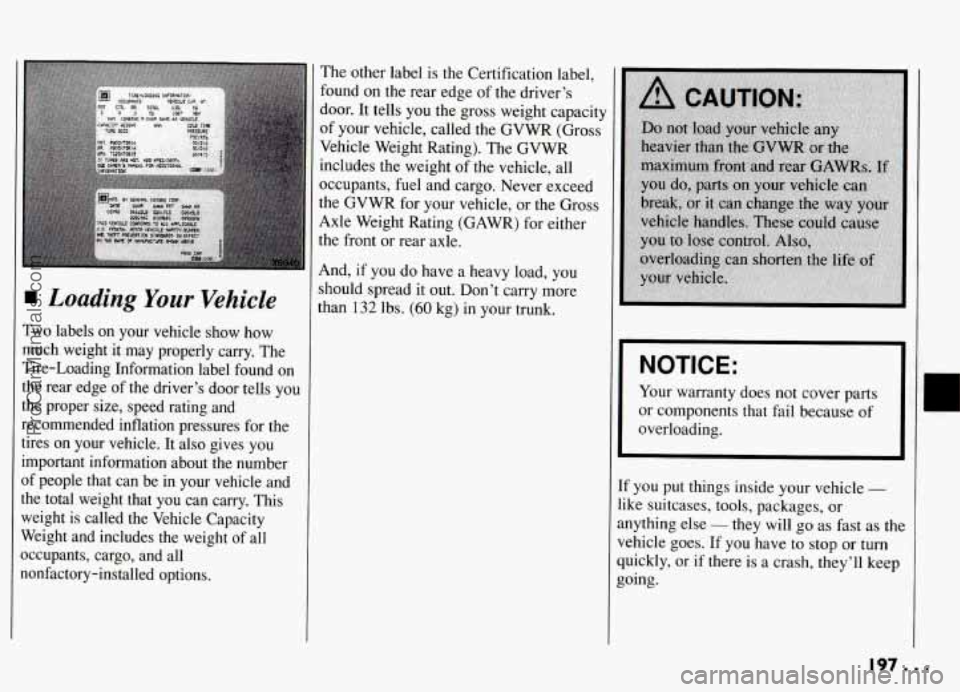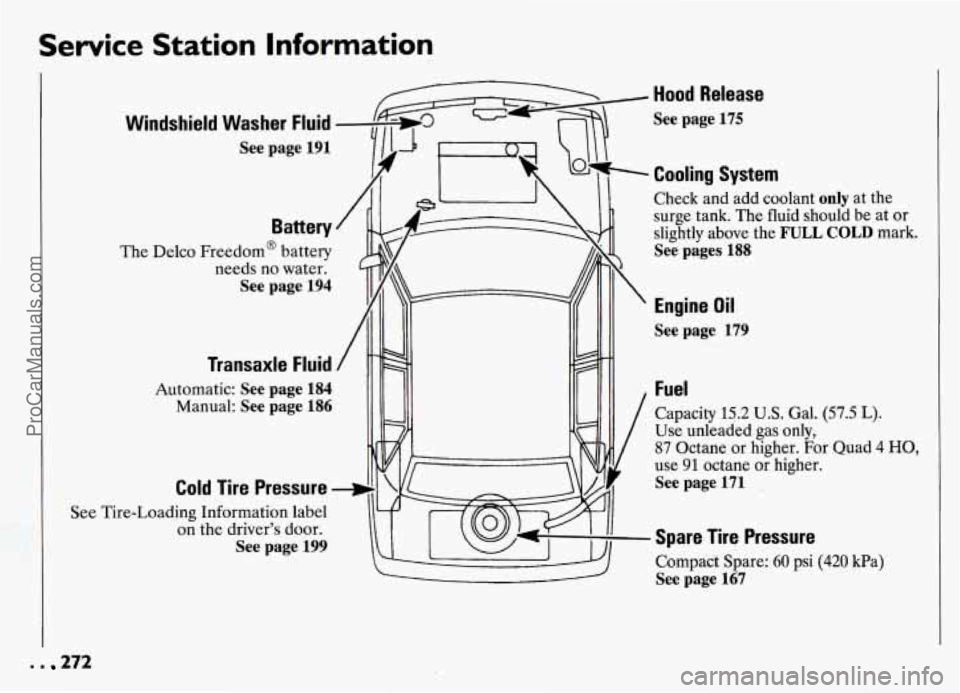1994 PONTIAC GRAND-AM load capacity
[x] Cancel search: load capacityPage 142 of 274

Towing a Trailer
NOTICE:
Pulling a trailer improperly can
damage your vehicle and result
in
costly repairs not covered by your
warranty. To pull
a trailer correctly,
follow the advice
in this section, and
see your Pontiac dealer for important information about towing
a trailer
with your vehicle .
Do not tow a trailer if your vehicle is
equipped with the 2.3L OHC or Quad 4
Engine (Code 3 or D).
Your car can tow a trailer if it is equipped
with the
2.3L High Output Quad 4 (Code
A) or 3.1 L V6 (Code M) engine and
proper trailer towing equipment. To
identify what the vehicle trailering
capacity is for your vehicle, you should
read the information
in ‘‘Weight of the
Trailer” that appears later
in this section.
But trailering is different than just driving
your vehicle by itself. Trailering means
changes
in handling, durability, and fuel
economy. Successful, safe trailering takes
correct equipment, and
it has to be used
properly.
That’s the reason for this section. In it are
many time-tested, important trailering
tips and safety rules. Many of these are
important for your safety and that of your
passengers.
So please read this section
carefully before you puli a trailer.
Load-pulling components such as the
mgine, transaxle, wheel assemblies, and
tires are forced
to work harder against the
jrag of the added weight. The engine is
required to operate at relatively higher
speeds and under greater loads,
generating extra heat. What’s more, the
trailer adds considerably to wind
resistance, increasing the pulling
requirements.
If You Do Decide To Pull A Trailer
If you do, here are some important points.
0 There are many different laws,
including speed limit restrictions,
having to do with trailering. Make
sure your rig will be legal, not only
where you live but also where you’ll
be driving.
A good source for this
information can be state or provincial
police.
0 Consider using a sway control.
You can ask a hitch dealer about sway
controls.
Don’t tow a trailer at all during the
first 1000 miles (1 600 km) your new
vehicle is driven. Your engine, axle or
other parts could be damaged.
Then, during the first 500 miles (800
km) that you tow a trailer, don’t drive
over
50 mph (80 km/h) and don’t
make starts
at full throttle. This helps
141
ProCarManuals.com
Page 143 of 274

Your Driving and the Road
Towing a Trailer (CONK)
your engine and other parts of your
vehicle wear
in at the heavier loads.
Obey speed limit restrictions when
towing a trailer. Don’t drive faster
than the maximum speed for trailers
(or no more than
55 mph (90 km/h))
to save wear on your vehicle’s parts.
Three important considerations have to do
with weight:
Weight of the Trailer
How heavy can a trailer safely be?
It should never weigh more than 1,000
pounds (450 kg). But even that can be too
heavy.
It depends on how you plan to use your
rig. For example, speed, altitude, road
grades, outside temperature and how
much your vehicle is used to pull a trailer
are all important. And,
it can also depend
on any special equipment that you have
on your vehicle.
A B
fou can ask your dealer for our trailering
nformation or advice, or you can write
us
It:
Pontiac Customer Services
Department
One Pontiac Plaza
Pontiac, Michigan 48340-2952
[n Canada, write to:
General Motors of Canada Limited,
Customer Assistance Center
1908 Colonel Sam Drive
Oshawa, Ontario L1H 8P7.
Weight of the Trailer
Tongue
The tongue load (A) of any trailer is an
important weight to measure because
it
affects the total capacity weight of your
vehicle. The capacity weight includes the
curb weight of the vehicle, any cargo you
may carry
in it, and the people who will
be riding in the vehicle. And if you will
tow a trailer, you must subtract the tongu
load from your vehicle’s capacity weight
because your vehicle
will be carrying tha
weight, too. See “Loading Your Vehicle”
in the Index for more information about
your vehicle’s maximum load capacity.
. . 142
ProCarManuals.com
Page 198 of 274

I Loading Your Vehicle
Two labels on your vehicle show how
much weight it may properly carry. The
Tire-Loading Information label found on
the rear edge of the driver’s door tells you
the proper size, speed rating and
recommended inflation pressures for the
tires on your vehicle. It also gives you
important information about the number
af people that can be in your vehicle and
the total weight that you can carry. This
weight is called the Vehicle Capacity
Weight and includes the weight of all
xcupants, cargo, and all
lonfactory-installed options.
The other label is the Certification label,
found on the rear edge of the driver’s
door. It tells you the gross weight capacity
of your vehicle, called the GVWR (Gross
Vehicle Weight Rating). The GVWR
includes the weight of the vehicle, all
occupants, fuel and cargo. Never exceed
the GVWR for your vehicle, or the Gross
Axle Weight Rating (GAWR) for either
the front or rear axle.
And, if you do have a heavy load, you
should spread it out. Don’t carry more
than
132 lbs. (60 kg) in your trunk.
I NOTICE: 1
Your warranty does not cover parts
or components that fail because of
overloading.
[f you put things inside your vehicle -
like suitcases, tools, packages, or
mything else
- they will go as fast as the
Jehicle goes. If you have to stop or turn
quickly, or if there is a crash, they’ll keep
going.
197.. .
ProCarManuals.com
Page 204 of 274

Your dealer will know the kind of wheel
you need.
Each new wheel should have the same
load carrying capacity, diameter, width,
offset, and be mounted the same way as
the one
it replaces.
If you need to replace any of your wheels,
wheel bolts, or wheel nuts, replace them
only
with new GM original equipment
parts. This way, you
will be sure to have
the right wheel, wheel bolts, and wheel
nuts for your Pontiac model.
NOTICE:
The wrong wheel can also cause
problems
with bearing life, brake
cooling, speedometer/odometer
calibration, headlight aim, bumper
height, vehicle ground clearance,
and tire or tire chain clearance to the
body and chassis.
Used Replacement Wheels
‘ire Chains
NOTICE:
If your Pontiac has P195/70R14,
P2 15/60VR 14, P195/65R 15 or
P205/55R16 size tires, don’t use tire
chains; they can damage your
vehicle.
If you have other tires, use tire
chains only where legal and on
when you must. Use only
SAE
Class “S” type chains that are the
proper size for your tires. Install
them on the front tires and tighten
them as tightly
as possible with the
ends securely fastened. Drive slowly and follow the chain
manufacturer’s instructions. If you
can hear the chains contacting your
vehicle, stop and retighten them. If
the contact continues, slow down
until- it stops. Driving too fast with
chains on will damage your vehicle.
lr
ProCarManuals.com
Page 273 of 274

Service Station Information
See
7
Windshield Washer Fluid
Battery
The Delco Freedom@ battery
needs no water.
See page 194
Transaxle Fluid
Automatic: See page 184
Manual: See page 186
Cold Tire Pressure
Tire-Loading Information label
on the driver's door.
Seepage199
- Hood Release
See page 175
- Cooling System
Check and add coolant only at the
surge tank. The fluid should be at
or
slightly above the FULL COLD mark.
See pages 188
Engine Oil
See page 179
Capacity 15.2 U.S. Gal. (57.5 L).
Use unleaded gas only,
87 Octane or higher. For Quad 4 HO,
use 91 octane or higher.
See page 171 .
- Spare Tire Pressure
Compact Spare: 60 psi (420 kPa)
See page 167
. . 272
ProCarManuals.com